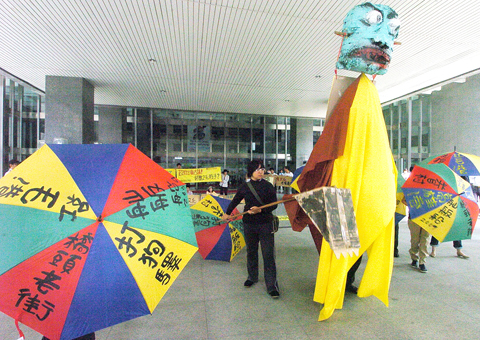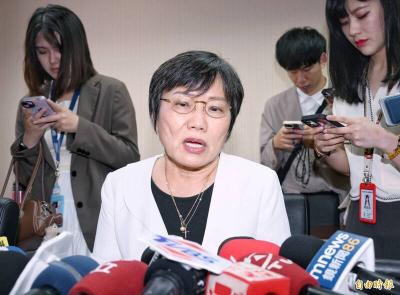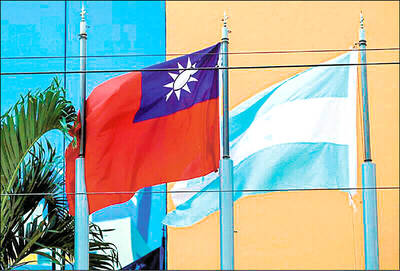When economic development dances with cultural heritage, it tends to result in something resembling a tug-of-war rather than a tango.
This struggle is perfectly illustrated by the relationship between a century-old train station in Kaohsiung and a city government preoccupied with efforts to boost the city’s economy.
Kaohsiung City Government has for years been dreaming of taking over jurisdiction of Kaohsiung Harbor from the Ministry of Transportation and Communications, partly because of the massive tax revenues the harbor can bring in.

PHOTO: HUANG JHIH-YUAN, TAIPEI TIMES
However, the harbor means more to the city than just its financial value, as it is the place where the city’s prosperity has its origin.
The harbor was inaugurated in the 1680s as a trade hub of Takao City (打狗), as Kaohsiung was then known.
Throughout the early 20th century under Japanese rule, the neighborhoods around the harbor — Hamasen (哈瑪星) and Yenchengpu (鹽埕埔) — grew much faster than any other parts thanks to the volume of traffic at the Takaoyi (打狗驛), now known as the Kaohsiung Harbor Station.
The station, established in 1900, was the city’s first railway station and controlled freight transport for southern Taiwan.
To accommodate the flow of goods in and out of the city, the train station operated 10 platforms connected to two harbor lines — one 13km route to what is now the downtown Kaohsiung Train Station and the other, 8.7km line to the Caoya (草衙) Switchyard in Siaogang (小港).
As the center of the city moved away from the harbor and highways replaced railroads in the freight business, the harbor train station’s influence gradually diminished, limiting its logistical value. The old harbor area withered as the station lost its economic importance.
After the Kaohsiung Harbor Station, including its platforms, was listed as a historical monument in 2002, the Kaohsiung City Government last year unveiled a plan to turn the surrounding area into a financial district.
A plan drawn up by the city government’s Urban Development Bureau calls for part of the 4.6 hectare harbor train station and its neighborhood to be turned into a 2 hectare financial district and a 0.5 hectare special cultural district.
The bureau also plans to introduce hotels and recreational businesses into the area.
The plan has drawn widespread criticism from local cultural groups and activists, who urged the city government to preserve the station and keep it intact, as they said it symbolized the city’s spirit.
“In 2008, the city government promised to turn the area into a railroad museum. The city government should keep its promise and think about how to revive the area instead of allowing construction companies to build houses there,” said Liu Chiu-er (劉秋兒), spokesman of the Takoayi Cultural Heritage Designation Alliance — an organization of about 30 local cultural figures.
Describing the city government’s plan as “totally wrong” and “unacceptable,” Liu said the alliance was never against developing the area, but the city government’s plan showed that “it had failed to connect the past [of the city] to its present and future.”
Liu said the alliance believed it would be better to revive the communities near the harbor by taking advantage of the station’s existing railways and the cultural landmarks along its two routes.
Rail services, which were taken out of service in November 2008, should be resumed and turned into a light rail transportation system, Liu said.
Such a system would be of value to tourism as there are numerous interesting cultural and artistic sites along the routes, including the Pier 2 Art District (駁二藝術特區) and a planned pop music center, he said.
Liu said the alliance planned to invite experts from relevant fields to deliberate the issues and pen another petition in greater detail for Kaohsiung Mayor Chen Chu (陳菊).
Lu Wei-ping (盧維屏), director-general of the city’s Urban Development Bureau, said the cultural groups should keep in mind that the residents of Yenchengpu and Hamasen would like to see the area renewed.
Lu said the old harbor area might face difficulties during renewal if the city government preserved every part of the station and did not introduce “proper business development opportunities and public facilities” to the area.
“Since Kaohsiung Harbor Station is a public asset, [the city government] should take both preservation of cultural heritage and urban development into consideration,” Lu said.
Hsu Ling-ling (許玲齡), a local cultural activist, said he feared that the century-old railway might be damaged during redevelopment.
Acknowledging the concerns, Kaohsiung’s Bureau of Cultural Affairs Director-General Shih Jhe (史哲) vowed to be cautious during the renewal process.

Chinese Nationalist Party (KMT) Chairman Eric Chu (朱立倫), spokeswoman Yang Chih-yu (楊智伃) and Legislator Hsieh Lung-chieh (謝龍介) would be summoned by police for questioning for leading an illegal assembly on Thursday evening last week, Minister of the Interior Liu Shyh-fang (劉世芳) said today. The three KMT officials led an assembly outside the Taipei City Prosecutors’ Office, a restricted area where public assembly is not allowed, protesting the questioning of several KMT staff and searches of KMT headquarters and offices in a recall petition forgery case. Chu, Yang and Hsieh are all suspected of contravening the Assembly and Parade Act (集會遊行法) by holding

PRAISE: Japanese visitor Takashi Kubota said the Taiwanese temple architecture images showcased in the AI Art Gallery were the most impressive displays he saw Taiwan does not have an official pavilion at the World Expo in Osaka, Japan, because of its diplomatic predicament, but the government-backed Tech World pavilion is drawing interest with its unique recreations of works by Taiwanese artists. The pavilion features an artificial intelligence (AI)-based art gallery showcasing works of famous Taiwanese artists from the Japanese colonial period using innovative technologies. Among its main simulated displays are Eastern gouache paintings by Chen Chin (陳進), Lin Yu-shan (林玉山) and Kuo Hsueh-hu (郭雪湖), who were the three young Taiwanese painters selected for the East Asian Painting exhibition in 1927. Gouache is a water-based

Taiwan would welcome the return of Honduras as a diplomatic ally if its next president decides to make such a move, Minister of Foreign Affairs Lin Chia-lung (林佳龍) said yesterday. “Of course, we would welcome Honduras if they want to restore diplomatic ties with Taiwan after their elections,” Lin said at a meeting of the legislature’s Foreign Affairs and National Defense Committee, when asked to comment on statements made by two of the three Honduran presidential candidates during the presidential campaign in the Central American country. Taiwan is paying close attention to the region as a whole in the wake of a

OFF-TARGET: More than 30,000 participants were expected to take part in the Games next month, but only 6,550 foreign and 19,400 Taiwanese athletes have registered Taipei city councilors yesterday blasted the organizers of next month’s World Masters Games over sudden timetable and venue changes, which they said have caused thousands of participants to back out of the international sporting event, among other organizational issues. They also cited visa delays and political interference by China as reasons many foreign athletes are requesting refunds for the event, to be held from May 17 to 30. Jointly organized by the Taipei and New Taipei City governments, the games have been rocked by numerous controversies since preparations began in 2020. Taipei City Councilor Lin Yen-feng (林延鳳) said yesterday that new measures by